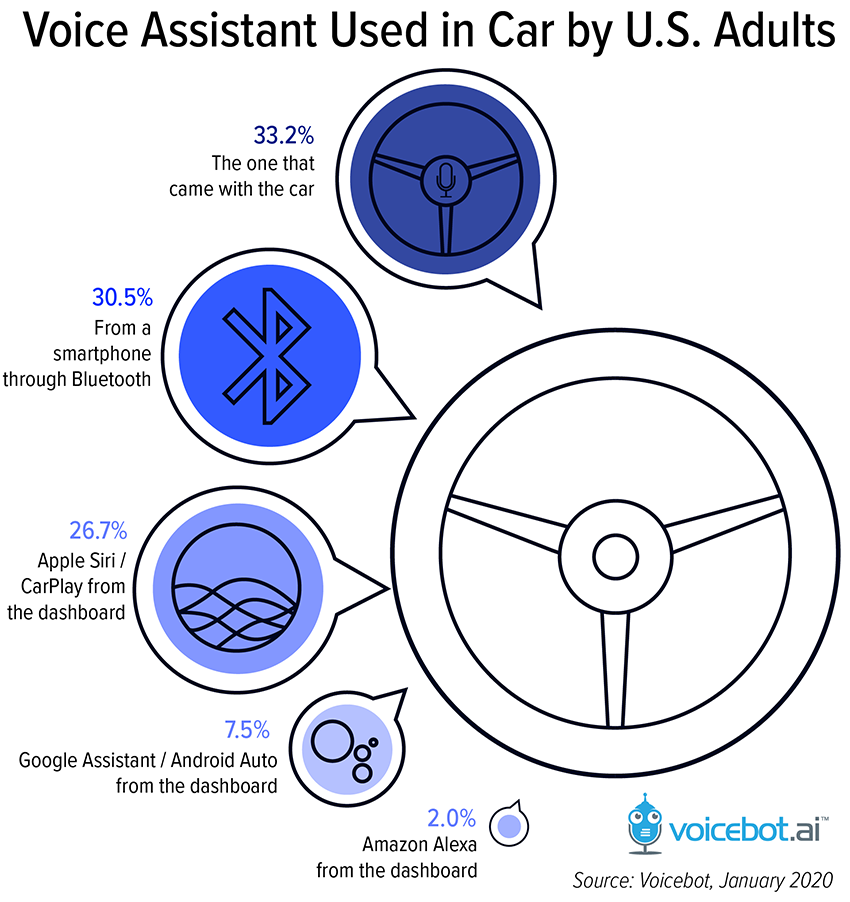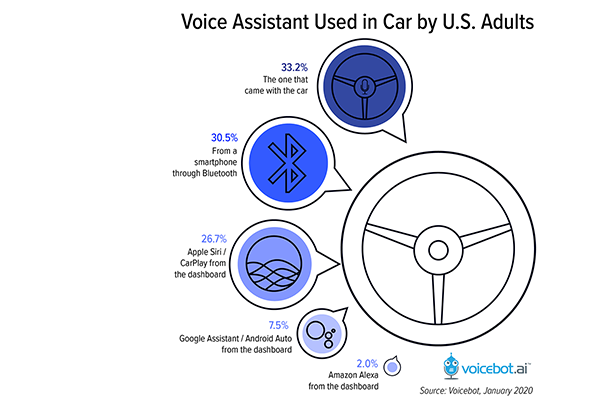More Consumers Use Embedded Voice Assistants Provided by Automakers Than Bluetooth to Smartphones or Apple CarPlay
- Embedded voice assistants provided by automakers are the most used assistants by drivers in the U.S.
- The second most used voice assistants while driving are through smartphones connected by Bluetooth
- Apple CarPlay is third most used and showed the biggest growth over 15 months rising to 26.7%
Embedded voice assistants provided by automakers are the most popular way for U.S. adults to use voice commands while driving according to a recent report by Voicebot in collaboration with research sponsor Cerence. The embedded assistants captured 33.2% share of in-car voice assistant use compared to Bluetooth connected smartphones at 30.5% according to a January survey of 1,090 U.S. adults. In September 2018, Bluetooth was in a virtual tie with embedded voice assistants but the Bluetooth market share of users has retreated about 1.5% while embedded assistant share has risen by over 1%.

You can download the full 40-page report with 19 charts and tables here. Download Now
Automaker Innovation Put to the Test
These changes are not giant leaps in either direction, but they are good news for automakers hoping to promote the use of embedded assistants. Automakers are responding to consumer demand to provide access to multiple general-purpose assistants but many industry executives have expressed reservations about handing control over user experience and data to any of the tech giants. Embedded assistants are designed to provide many of the features consumers want from voice assistants without turning the engagements over to an outsider while also adding capabilities to use voice control for car features.
Embedded voice assistants in cars certainly aren’t new. They have been around at least since 2000 in some luxury cars. However, the rise of consumer voice assistants such as Alexa, Siri, and Google Assistant has created a “share of voice” conflict over which assistant will be available to drivers for a variety of use cases. In many instances, voice assistants cannot operate simultaneously. Some industry observers have doubted that automakers would fare well in this competition with savvy product innovators from Amazon, Apple, and Google. However, Sanjay Dhawan, CEO of Cerence, sees the inherent advantages that embedded assistants have in providing value to drivers:
“We know that drivers want access to a wide variety of voice assistants, services and content while they’re in the car. That said, the dedicated in-car assistant has a depth of knowledge of the car itself that these other assistants and services simply cannot match. When you look at what drivers are looking to accomplish in the car, it makes sense that the in-vehicle assistant is best suited to serve them.”
Apple CarPlay On the Rise
The biggest immediate threat to automakers for driver “share of voice” appears to be Apple CarPlay. Alexa use is minimal and Google Assistant through Android Auto is down slightly as is access to smartphone assistants via Bluetooth. By contrast, CarPlay rose from 20.7% relative share in late 2018 to 26.7% in January 2020. That is 6.5% behind the share of embedded voice assistants but CarPlay has shown a much faster growth rate. Apple provides a simplified infotainment experience compared to embedded systems, but it has a large and growing constituency based on the data.
How Will Alexa Auto and Google GAAS Affect the Trends?
For the near term, embedded voice assistants look poised to grow market share. Improved user experience, reliability, and feature breadth all make the native solutions appear increasingly attractive to drivers. Cerence and SoundHound are well-positioned to help automakers continue this trend and Microsoft Connected Vehicle Platform (MCVP) could also help propel these efforts as mentioned in the full report.
However, the emergence of Alexa Auto and Google Android Auto OS (GAAS) will present a bigger challenge. These solutions are designed to replace embedded assistants or at least take over more voice interactions over time. It will take a couple of years to determine whether these solutions are widely adopted, but you can imagine embedded assistants becoming subordinate to Alexa and Google Assistant where infotainment operating systems are provided by Amazon and Google.
This is also why Cerence’s new Cognitive Arbitrator which was announced this week is particularly interesting. In cars that sometimes provide access to 3-5 voice assistants from different providers, who is responsible to determine which assistant answers a request? We could place that burden on the user to remember which assistant to invoke. Cerence suggests an AI-based arbitrator can field requests and dynamically assign them to assistants based on their capabilities or known consumer preferences. The owner of the arbitrator then asserts ultimate control over the user experience and the role each assistant plays. That is likely to be attractive to automakers no matter which infotainment OS they ultimately choose.
The 2020 In-Car Voice Assistant Consumer Adoption Report is available now for download. Nineteen charts and tables are included in a 40-page analysis that covers a wide range of topics including:
- Market size and growth rate for voice assistant use in cases in the U.S.
- Consumer expectations about future use of voice assistants while driving
- Frequency of use of voice assistants in cars
- A rank-order of common use cases where drivers employ voice assistants
- The impact of voice assistants on car purchase decisions
- And much more…
Follow @bretkinsella Follow @voicebotai









